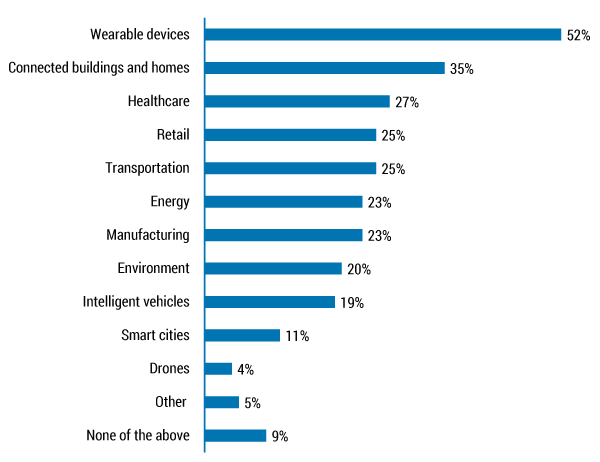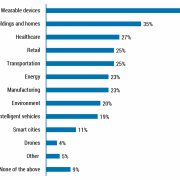Data Analytics & Digital Technologies Executive Update, Vol. 15, No. 23
In June through October of 2015, Cutter Consortium conducted a survey asking organizations worldwide about their thoughts and plans for the Internet of Things (IoT).1
Which IoT Technologies and Practice Areas Hold the Most Promise?
Figure 1 shows the IoT technologies and practice areas that survey respondents indicate hold the most importance for their organizations or businesses.

Wearables
The IoT applications and devices that organizations are currently most interested in are wearable devices like smartwatches (Apple Watch, Samsung Gear, etc.), activity/fitness trackers (Fitbit, Misfit, etc.), and smart badges (for location tracking and security).2 More than half of respondents believe wearables hold the most promise for their organization. This makes sense because wearables are a technology we can apply across multiple categories, ranging from healthcare and fitness to manufacturing, energy and retail.
An up-and-coming area for wearables development is textile sensors, which developers are embedding within the fabric of clothing to create “smart fabrics” and “smart clothing” that can function as biometric, data-gathering devices. Examples include shirts, sports bras, smart socks, and shoes, among other items. Such garments capture and relay heart rate, activity, running form, fitness levels, and more. Some very innovative clothing designed for consumer fitness, healthcare, business, sports, military, and other uses in this hot application area are hitting today’s market.
Connected Buildings and Homes
The consumer-connected home market is seeing lots of innovation with smart devices, with new products continually appearing for the kitchen, entertainment, personal care, and a multitude of other uses.
“Smart buildings” is another area seeing considerable innovation. These products are designed for home, business, and industrial use and range from connected thermostats, smoke detectors, and HVAC systems to intelligent lighting, security (video, sensors, etc.), elevators, and smart utility meters.
The combination of smart devices and analytics is a hot application area for smart buildings, especially for commercial buildings. Buildings generate a huge amount of data from systems utilized in their operation. By analyzing and correlating this data, organizations hope to achieve savings in the form of building and energy efficiency and optimized maintenance.
Healthcare
Healthcare is witnessing an unprecedented amount of innovation in connected devices. The development of mobile health and fitness apps has exploded, as suggested by the wearables category above.
Some companies are developing apps that provide consumers and patients with information on various illnesses and diseases — everything from how to deal with the common cold or flu to coping with diabetes and Parkinson’s disease. Others are developing fitness and health apps designed to utilize the sensors built into popular Apple iOS and Android smartphones.
Companies are also developing connected medical devices for specific healthcare uses and add-on components for linking their various health devices with apps running on popular mobile devices. These sorts of devices range from connected thermometers, blood pressure monitors, and weight scales to breathalyzers, ultrasound devices, and more. In short, the development of sensor-enabled, wearable medical devices that can communicate their readings to users (patients) and/or physicians wirelessly has exploded over the last year.
Other developments include the use of RFID tags on patients and hospital equipment for tracking, monitoring, and optimizing resource allocation and streamlining processes. The goal with RFID is to ensure that vital medical equipment is where it needs to be when it needs to be there, that it is operational (so as not to delay a costly procedure), and that the patient receives the correct treatments.
For more on how connected devices and applications are transforming medicine, fitness, wellness, and healthcare, see my Executive Report “How Mobile, Cloud, and Big Data Are Transforming Healthcare and Medicine.”
Retail
In addition to a myriad of mobile retail applications designed to enable one-to-one communication with consumers, other trendy connected retail apps include those for mobile shopping that can communicate with sensor-enabled displays for responsive digital signage and shelf management (e.g., dynamic markup/reduction of shelf items and inventory).
More advanced retail applications include digital shopping carts and “virtual fitting rooms” equipped with “smart mirrors” designed to give shoppers a more interactive and personalized in-store experience, as well as location-based tracking and monitoring of customers’ mobile devices in order to capture and analyze in-store movements.
Sensor-enabled displays and lighting allow retailers to make more efficient use of floor space and other store areas. The use of dynamic sensors on shelved and stocked items enable electronic pricing of store inventory in response to weather, seasonal, and consumer trends identified through big data and social media analytics efforts. These are also popular areas for connected retail systems development. In short, the IoT and connected applications are going to redefine the retail industry.
Transportation
The transportation industry is widely deploying sensors, mobile, and analytics — including for applications in transport and shipping, which utilize sensors on aircraft, locomotives, trucks, shipping containers, and packages.
Companies are developing connected transportation applications to enable better management of fleet and urban transit vehicles, railroads, and associated infrastructure by using predictive maintenance and to achieve reduced energy consumption via optimized route planning and delay avoidance. Such applications are certain to grow dramatically over the next few years — for safety, route planning, and smart parking, in particular.
Energy
IoT and connected applications in the energy industry are focusing on sensor-enabled systems for smart grid management and minimizing the environmental impact of installations (transformers, switching centers, etc.), and for monitoring and protecting vital, remotely deployed assets, such as wind farms, pipelines, solar power facilities, and pumping stations. Drones are also undergoing testing to monitor remote facilities, including pipelines and electrical transmission lines (see the “Drones” section below).
Manufacturing
Manufacturing and process industries have made widespread use of sensors and mobile technology to monitor and measure equipment, vehicles, material, and processes for some time now. This trend will accelerate over the next 24 months.
Industrial Internet applications utilize sensors combined with analytics deployed for use with complex industrial equipment. By collecting and analyzing sensor data pertaining to various operational variables (pressure, temperature, vibration, etc.), it is possible to determine which machines and processes are functioning correctly or require attention. Data collection and analysis can also support predictive maintenance, which holds the possibility of becoming one of the IoT’s killer apps. Other IoT manufacturing and process control applications include monitoring and tracking the location and status of sensitive equipment, parts, and material in the supply chain or production process.
An important developing trend is that manufacturers now seek to apply sensor-enabled devices to support more human-centric monitoring in industrial settings. This includes the use of mobile devices on the factory floor to enable workers to interact more directly with the systems and processes required to perform their job functions as well as the application of sensor-enabled devices, clothing, and equipment to sense the status of people in relation to their operating environments and their exposure to environmental conditions. This comprises tags, badges, wristbands, gloves, and other wearables that can detect a person’s posture or exposure to the environment based on their location, activity, temperature, humidity, and other factors. Applications consist of those for location tracking, fall detection, and vital-sign sensing of workers and first responders operating in hazardous scenarios.
Environment
The IoT will have a tremendous impact on environmental protection, too. This will come about from companies, researchers, media, watchdog groups, and ordinary citizens using wireless sensors, video, and drones for real-time or near-real-time environmental monitoring, pollution control, and facilities management and maintenance. The goal is to prevent and detect pollution from sources such as chemical tanks, sewage, and pipeline leaks as well as naturally occurring events like algae blooms and fish kills. Sensor-enabled applications will also change the management of natural resources (parks, wildlife refuges, marine habitats, oceans, waterways, etc.).
There are a range of options for sensors used in environmental applications (water monitoring, chemical leak detection in rivers and lakes, levels of seawater pollution, etc.). These include sensors designed for very low-power usage as well as those for deployment in rough environments and difficult-to-access remote locations. In addition to advances in battery technology, some environmental sensor applications use solar panels for recharging, providing a degree of autonomy.
Intelligent Vehicles
We can consider intelligent vehicles as part of the “transportation” category considered earlier. However, I have chosen to differentiate them to aid discussion. Intelligent vehicles include self-driving vehicles as well as connected vehicles equipped with route optimization, safety monitoring (for insurance and emergency response needs), and other vehicle-detection and collision-avoidance systems.
Connected cars is an area seeing increased innovation. Connected car solutions integrate critical in-vehicle data, data communications, and multiple sensors to turn vehicles into information hubs that can perform various tasks. For example, each car can monitor nearby vehicles to avoid road accidents, communicate with transportation infrastructure to optimize routes, collect sensor data to determine vehicle status, and provide infotainment to vehicle occupants.
Self-driving vehicles will eventually disrupt the taxi, rental car, insurance, and, in the foreseeable future, long-haul trucking and delivery industries. This is why companies like Google, Apple, Uber, and major automobile and truck manufacturers are developing self-driving vehicles. Nobody is certain how self-driving vehicles will affect these markets, but most innovative companies do not want to be left out of the big changes certain to take place.
Smart Cities
Using connected devices and supporting analytics for the administration and management of cities is an IoT area that is really just in its infancy. Key areas include such connected infrastructure as water and waste management, lighting, traffic, and security.
Smart city initiatives employ sensors widely across various scenarios — including in streets, trash receptacles, parks, recreational areas, and other public spaces to enable better allocation, distribution, and management of resources based on information from incidents and services. Such initiatives also monitor and analyze the movement of people and vehicles for traffic management, parking capacity optimization, crowd control, and waste management. By broadly deploying cameras and other sensors and conducting analysis on the data generated by such devices, officials can better prepare for and react to potential bottlenecks, shortages, emergencies, and other issues.
A key trend for smart cities is the use of intelligent street lighting to provide infrastructure for various security, first responder, and community service needs. Such lights display messages and video on screens and broadcast public service announcements and other audio/video alerts. They can also record video and audio in situations such as political rallies, demonstrations, conversations, gunfire (including conduct triangulation), and other activities happening in public spaces to support tourism, entertainment, security, and law enforcement. Another trend is the use of social media analysis to discover posts by citizens reporting bad weather, traffic jams, crime, and so forth, to enable planners to react more efficiently.
Drones
Organizations surveyed expressed the least interest in the commercial use of drones when it comes to IoT applications that appear promising for their businesses. Nonetheless, we are seeing many startups hoping to change this attitude.
The commercial use of drones, for the most part (especially in the US), remains restricted to their use in areas/applications remote in nature or which tend to involve limited numbers of people. Although Amazon, Walmart, and others have made significant noise about using drones for delivery purposes, the primary use of drones is for collecting data via onboard sensors. This will remain the case for at least the next 12 months, and probably longer.
Drones are frequently used in the TV/motion picture industry for aerial filming on closed sets. Agriculture is another major area for drones. Usage includes conducting high-resolution imaging for crop management, for example, to help farmers with the precise application of fertilizer and pesticides, for irrigation purposes, and for disease identification on crops.
The use of drones for factory/facilities monitoring and maintenance is also increasing. Applications range from monitoring flare stacks and remote pipelines at oil and petrochemical facilities to the inspection of electric power lines and aerial surveying of railroad yards. Expect the use of drones for industrial facilities monitoring and maintenance to take off upon finalization of drone regulations.
Aerial surveying, in general, is becoming a major area for drones, and a rash of startups focusing on drone surveying services for various industries has emerged. Using drones for shooting still photos and video of real estate, for instance, is practically a mom-and-pop industry in the US. Moreover, the engineering and construction fields use drones for inspecting bridges and other structures and for maintaining aerial surveillance of large construction projects. In addition, law enforcement, rescue personnel, and other first responders are starting to test drones; we will surely see an uptick in drone usage in this area, too.
As drones become more accepted, many companies will opt to outsource their drone needs to a drone services provider specializing in certain applications and industries to avoid having to maintain their own drone assets.
Conclusion
Our research points to a number of findings pertaining to trends influencing organizations’ plans to develop connected devices and other IoT applications, including:
- Wearables are overwhelmingly the most promising of the IoT technologies and application areas. Wearables will see increasing innovation and usage across most industries and applications, including consumer (fitness), healthcare, business, sports, military, manufacturing, and others.
- Connected buildings and homes are very attractive for IoT product and service development. We are already seeing myriad consumer offerings designed for the smart consumer home. This trend will increase in 2016, really taking off in 2017. Smart building systems intended to optimize the operation of commercial buildings will also experience considerable growth over the next 12-18 months.
- Healthcare in 2015 saw a huge amount of innovation around the development and use of connected devices and cloud analytics. Expect this trend to increase dramatically over the next two years, with no letup in sight.
- Retail will be redefined by the IoT. In 2015, we saw the use of mobile consumer shopping applications take off. We also saw the introduction of more advanced retail apps designed to give shoppers a greater interactive and personalized in-store experience. In 2016, these more advanced connected retail applications will start getting more widely deployed.
- Transportation already makes wide use of connected solutions and analytics for applications in transport and shipping, fleet and urban transit vehicle management, optimized route planning, and smart parking. Such applications will grow dramatically over the next few years.
- The energy industry is focusing on connected solutions for smart grid management and limiting environmental impact, including the use of drones for monitoring remote facilities. Development and use of smart systems for optimizing energy production will accelerate in 2017, as will drone testing.
- Manufacturing and process industries will significantly expand the use of sensor-enabled machines and mobile devices in 2016. Manufacturers will also turn to using sensor-enabled devices to support more human-centric monitoring in industrial settings over the coming year.
- Environmental protection will undergo a dramatic transformation via the use of low-cost, easy-to-use sensor devices by companies, organizations, watchdog groups, and concerned citizens. Drones, in particular, will be game changers, allowing immediate flyover and analysis of areas impacted by spills and other contamination.
- Intelligent vehicles are currently dominated by connected cars, which are seeing the most commercial success. However, self-driving vehicles will eventually lead to significant disruption in various industries, including taxi, rental car, insurance, and even long-haul trucking and delivery. Self-driving vehicles also hold the potential to change car ownership trends.
- Smart cities is an area of the IoT just starting to get going. Most initiatives will not get underway until 2017.
- Drones hold the least amount of interest among IoT-connected devices. The commercial use of drones is still in its infancy. Mainstream commercial drone use will not get underway until 2017, at the earliest, or until the formalization of regulations governing their use.
This concludes our Update series on the IoT. As always, we welcome your feedback. You can comment below, or email me at chall@cutter.com.



